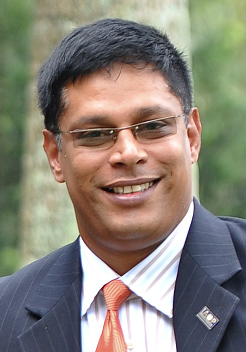By Bobby Varanasi, COP, COP-GOV
Varanasi, Chairman/CEO & Founder of Matryzel Consulting, is one of the acknowledged Top 25 Globalization Leaders in the global sourcing space. He sends in this piece to IT Edge News from New York, USA.
A trillion dollar industry, over ten million direct jobs, forty nations vying for a piece of this global pie, multitude of solutions and services crafted on the back on process and technology prowess, complimented by global communications networks, have resulted in a thriving global services industry. A slow and steady, yet concerted progress toward embracing some elements of business complexity, supported by collaborative endeavors and (transactionally) savvy provisioning seems to have come a full circle now. Gone are those excitable conversations around sourcing, and functional transformation through provisioning cheap and competent labor. Gone are those aspirations to compete on arbitrage – whatever be the elements. And gone are those comparative indexing of nations/ markets/ cities / companies on basis of delivery capabilities pigeonholed in operational efficiencies.
Nikolai Kondratiev had way back in 1925 articulated the fundamental shifts in economic cycles, almost always riding a progressive wave of ingenuity and innovation, and sliding down the crest through excessive indulgence in replication and upending competition, till the next wave began. While he termed the current phase as the 6th wave of economic transformation (driven of course by a view to global microeconomics and not specific to any industry), we tend to term this phase as the fourth industrial revolution. Whatever the nomenclature, we could either accept that shrinking cycles to ingenuity have always led to new cycles replacing the old, hence this 4th IR isn’t surprising. Or we can take a much broader, bolder analysis of the current cycle, however disconcerting it may be, with an intent to determine how this wave seems to be fundamentally distinct from all the others, pertinently with a specificity limited to global services.
“The outsourcing model of yesteryears is perhaps dead. Let’s not flog it for its inability to stand today’s tests, because an inherently moral argument is that while it lasted, it did create value.”
Dissecting Provisioning Models
We are aware of the recent turmoil in the industry, where provisioning models have come under severe strain, not from their efficacy. Instead, it came from their continued adherence to fairly rigid contract terms. Meanwhile client entities have over the past few years begun to appreciate the flexibility accorded by the shared services model more than they had earlier. Complimenting such thinking was the need for moving away from discrete to a multi-functional integrated view to provisioning. As middle office became the new back office, previously hailed service models began to come under heavy strain. One can see from the reduced tenors and size of deals, to vendor consolidation amongst clients as being some of the more immediate responses to a failing traditional outsourcing model. Meanwhile, providers that recognized this trend began to see their deals truncated, pricing pressures increase (and consequently margin pressures go up), and previously loaded balance sheets come under heavy strain.
Of course, one can argue this is old news. Contrarily, I would imagine that not paying enough attention to the attendant causes for such shifts (where providers went from darlings to pariahs) is akin to inviting similar woes yet again. Dissecting the subtle changes that led to this tumultuous situation warrants more attention, and not be relegated to the standard argument one hears, that disruptive technologies are the only ones to be blamed. Some significant shifts over the past decade, particularly manifested in “consequences of commoditization” are crucial to appreciate.
“Significant shifts in provider-buyer relationships have manifested into “consequences of commoditization” that need to be understood better. Middle office is the new back office.”
Consequences of Commoditization
First, with familiarity comes increased ability to replicate, despite claims to ongoing improvements, since such changes are only marginal for the client, measured by increased efficiencies. Most value from such familiarity and replication rubbed off only on providers, leading to increased efficiencies at delivering the same services. Providers began to differentiate less through articulation of “actual value” and more via “distinction with efficiency loading”. Such endeavors from a client standpoint could only mean one thing – sharing in the spoils of increased efficiency. Some vendors did pass on the benefits, while most did not. This manifested particularly in clients asking for reduced pricing for same services, or more services for same pricing. This trend cannot be underplayed as it underpins all the consequent woes of commoditization.
Second, providers that began to embrace new technologies did so more on the pretext of offering distinction – where none existed in competitive comparison – while remaining within the confines of their own contractual obligations and service-heavy / process-heavy input-centric offerings. This could be done by doing the only thing they knew well – milk the efficiency bandwagon some more. Today’s ubiquitous “as a service” platforms across the business and technology layers (again within back-office environments) were aggressively adopted by providers, resulting in retaining some relationships. However, in a quest to incrementally increase value for clients, an approach pigeonholed in back-office relationships did nothing more than contribute to marginal efficiencies and reduced duplicity. The transient nature of such endeavors wasn’t appreciated enough, leading to diluted and truncated relationships.
Third, with clients moving from a siloed approach toward an integrated multi-functional view to managing their businesses needed insights, and support necessary to transform their middle offices. This could only be undertaken in collaboration with partners that understood nuances of client industries. Provider insufficiency with such knowledge is well known, yet least easily accepted. The reason for such push-back has always been an argument proffered by providers that their vertical-centricity should necessarily take care of any gaps in their knowledge of clients’ core businesses.
“The “new” layers itself on top of the “old”, creating an illusion of progress, yet may be the one crucial linchpin between value creation and ignominy.”
This argument doesn’t hold much water, given that most providers that chose to verticalize their service offerings didn’t do it on the back of integrated value (as their marketing collateral portrays), as much as on the back of risk diversification (focused on reduced loading on their P&Ls from deals and tenors across clients from multiple industries). A very few providers chose to do the right thing, while most approached such concentration toward client businesses opportunistically. Financial results of global public listed providers in 2016 reflected this dichotomy: almost single-digit margins and growth by large offshore players, and large double-digit growth and margin figures by multinational players.
Fourth, a crucial trend that has for long been consecrated to the backburner has suddenly become center-spread. It is a well-known economic perspective that with each change in the marketplace (social, economic, structural, regulatory, competitive, legal or cross-border), a “new” form emerges that in turn influences policy and industry, technology and marketplace. Interestingly however, the “old” remains in the system, and doesn’t necessarily go away as much as one would like to wish. This layering of the new on the old over decades has resulted in a four-layer industry today that needs to be better understood if only to ensure zero value erosion.
“Entrenchment is the only plausible solution for the industry to move from the fringe to center-stage.”
The “new” is not just about provisioning but fundamental shifts (and discards) with business models, operating models, consumption models, measurement models, risk-loading and risk-sharing models, pricing and accountability models, governance models, and most crucially, performance models. All these need to be delved into more comprehensively while acknowledging that a mature provider-buyer relationship can only be built when both sides are collaborating through their presence within the same layer of maturity.
Fifth, advent of new technologies aimed at eliminating most transactional rigor associated with human interventions has created a significant opportunity for organizations to reallocate scarce capital into more productive, topline oriented roles that need foresights, competencies, insights and decision-making capabilities. Organizations with heavy fixed costs associated with transactional tasks find these new technologies a key step toward spiraling their organizations from an inherent rigidity to market-aligned agility. The tyranny of process is fast being replaced by the opportunity of flexibility. Automation has come to promise a lot more than it is understood to be able to deliver upon.
Yet one cannot blame organizations for thinking “agility” as their key route to competitiveness and management of complexity. If such agility comes at the cost of reducing transactional rigor, then it should be adopted with unfettered abandon. This shift is reflected in an increased demand for transactional automation, where a non-biological workforce is being increasingly sought as a replacement.
The question on what to do with the replaced biological workforce is a large and complex discussion that I shall address in another paper. Suffice it to say that today’s opportunities around resources span both physical and virtual, hence balancing the two will need us to create new thinking, while discarding what we have always known as the way to manage.
Meanwhile, it becomes critical that provider models – pigeonholed in transaction-heavy services – need to align themselves strategically to such shifts. Instead, if adoption of technologies is premised purely on what clients ask, and rarely undertaken proactively as a prelude to remaining competitive, I believe their businesses will face obsolescence very soon. Margin bleeds are one of the many leading indicators calling for such changes. However, should it be viewed as a function of (sic) poor management of the balance sheet, any gains made from previous relationships stand to be eroded quickly.
As advisors, we urge providers to undertake a comprehensive, and honest analysis of bleed with competencies an not waste too much time on downsizing, increased emphasis on operational efficiencies, productivity loading et al (that may seem like strategic levers aimed at transformation, yet are nothing more than operational hit-and-miss activities) that do nothing more than support an illusion of normalcy. Management theory and financial acumen cannot unfortunately save such rigid input-heavy models from ignominy.
“Shrinking cycles to ingenuity have always created fundamental shifts. Human ability to adapt to incessant change is the conundrum.”
Conclusion
Providers are galore. Many may emote about their ongoing rigorous adoption of most modern and disruptive technologies, yet most tend to remain aloof when it comes to value-alignment with the business models of their clients. Client entities are fast building their front-line models to create topline value, and expecting their providers to help them with that journey. Providers in the meanwhile are slow to build solutions owing to (a) their own model rigidities, entrenched in revenues based on input-heavy provisioning of transactional efficiencies, (b) inability to take crucial strategic decisions that border on both cannibalization, and rejection of obsolete services, (c) responsive-nature built on client ask instead of creating for the future, and (d) promises from new-age businesses that are today able to upend traditional provisioning models through technologies in a manner never envisaged or anticipated earlier.
The outsourcing model of yesteryears is perhaps dead. Let’s not flog it for its inability to stand today’s tests, because an inherently moral argument is that while it lasted, it did create value. I shall agree, yet will defer any pronunciations around demise, in the absence of concrete proof. Irrelevance and ignominy are not the same as obsolete. Provisioning models shall remain. Their manifested nature will however have to catch up with the times, and most importantly with the progress of their client organizations. Entrenchment is the only plausible solution going forward, and perhaps the only option left for the industry to move from the fringe to center-stage.
ABOUT THE AUTHOR

Bobby Varanasi
Bobby Varanasi is one of the acknowledged Top 25 Globalization Leaders in the global sourcing space and the Founder of Matryzel Consulting – an independent advisory firm that has been acknowledged as one of the World’s Best Outsourcing Advisory Firmsthree years in a row (2013, 2014 and 2015). He brings with him two decades years of experience in consulting and management across IT, Business Services and building global operations. He advises federal governments across four continents on ICT sector development with particular emphasis on policy development, industry-government partnerships aimed at creating domestic resilience through increasing productive (and inclusive) faculties of entrepreneurs. Bobby also advises Fortune 500 customer organizations and emerging market entrepreneurs on strategy, growth, sourcing and expansions. He is often quoted and published in Forbes, fDi, Economist, The Outsourcing, ICT Media BV, Ratio Magazine Africa, etc.
Bobby holds Board positions with the International Association of Outsourcing Professionals (IAOP) – a global standard setting organization for the sourcing industry; the Global Sourcing Council (GSC) – an entity focused on sustainable and socially responsible sourcing practices (both headquartered in New York); and the Malaysia Australia Business Council (MABC) – an entity focused on cross-border trade enablement. He is an Assessor & Mentor, Product Development & Commercialization Fund (PCF), established and managed by Malaysia Digital Economy Corporation, Govt. of Malaysia that focuses on new technologies, new trends and entrepreneurship development.
He is author of a book titled “Humanomics – Making Sense of Socio-economic Impacts of Global Sourcing”published by Author House (a Penguin Random House company), which is available on Amazon, Google Books etc. An avid scuba diver and basketball player, he currently splits his time between Newark, DE, USA and Kuala Lumpur, Malaysia with his wife and two sons.





























